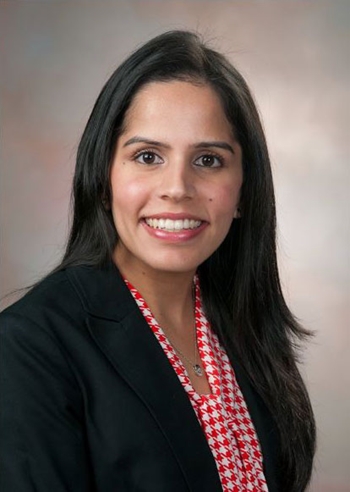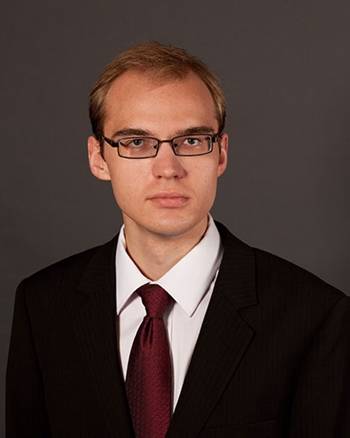By Akriti Khanna, MD, and Scott J. Adams, MD
ACR Amis Fellowship in Quality and Safety
Akriti Khanna, MD, is a resident at the Cleveland Clinic, and Scott J. Adams, MD, is a resident at the University of Saskatchewan. They are currently the American College of Radiology® (ACR®) E. Stephen Amis, Jr., MD, Fellows in Quality and Safety. Now midway through the Amis Fellowship, they provide insights into their experiences to date.
 Akriti Khanna, MD |
 Scott J. Adams, MD |
What has been the most unique aspect of the Amis Fellowship so far?
Dr. Adams: The E. Stephen Amis, Jr., MD, Fellowship in Quality and Safety is unique in that it allows residents to gain a “behind the scenes” perspective of quality and safety programs at the ACR. The ACR Department of Quality and Safety oversees programs ranging from practice parameters and technical standards, accreditation, peer review and the ACR National Radiology Data Registry. Engaging in the Department of Quality and Safety — and appreciating the full breadth of activities within the department — has provided important insights into how I may be able to draw upon resources of the ACR to improve my health system, engage in leadership in quality and safety, and contribute to organized radiology in the future.
Dr. Khanna: During our fellowship, we have a full week dedicated to understanding the ACR as an organization. We get a full introduction to the programs and services that the ACR offers, including the accreditation programs, data registries, lifelong learning tools, publications, the ACR Data Science Institute® and the reporting systems, to name a few. It is a fast-paced way to experience the various aspects of the ACR and understand the multifaceted nature of our field. During this week, I gained a greater appreciation for the extent of tools and guidelines the ACR offers. A plethora of resources are available to guide radiologists in the clinical practice and the improvement of radiology. Carefully curated ACR Appropriateness Criteria® documents crafted with expert consensus, Reporting and Data Systems (RADS) frameworks, contrast manuals, Radiology Leadership Institute® programming, and concise informative publications like the JACR® and ACR Bulletin have really given radiologists rich resources to navigate the ever-changing nature of medicine. Getting a rapid overview of these programs was a very unique aspect of the fellowship that I truly enjoyed and learned a lot from.
What has been your favorite experience as an Amis fellow?
Dr. Khanna: My favorite experience has definitely been meeting and getting to know all ACR staff and personnel. In the process of learning about various ACR initiatives and departments, we have had the opportunity to spend time with the people who run these programs day-in and day-out and who have an in-depth understanding of program operations. While I had previously pictured the ACR to be a nebulous organization with many unrelated parts, I quickly realized that it actually consists of many talented and dynamic staff who are passionate about their work. They are incredibly knowledgeable about the nuances of ACR functions and don’t actually work in silos, but in a very cohesive, collaborative way. The staff of different subdepartments know each other well and work together seamlessly to keep their efforts in sync with the overarching goals of the organization. I was fortunate to make incredible contacts with ACR staff and started associating faces and people with programs, making the various ACR activities tangible entities that really came to life. I hope to maintain these contacts and relationships going forward and know I can reach out to these experts whenever I need some direction.
Dr. Adams: I would echo Dr. Khanna’s sentiment that many insightful conversations with members of the ACR Quality and Safety team have certainly been highlights of the fellowship. There are many talented and dedicated people at the ACR who support radiologists in providing the best imaging care possible for our patients. It’s a great group at the ACR, and their work truly contributes to the advancement of the specialty of radiology.
What advice would you offer other radiology residents and fellows as a result of your experience during the Amis Fellowship?
Dr. Adams: I would encourage residents and fellows to engage in quality and safety — to read about theoretically-informed approaches to quality and safety, to hear success (and failure) stories from other institutions, and to engage in work that strives to improve quality and safety at their own institutions and more broadly across the specialty and health system. Regardless of our individual roles in our practices, and regardless of our career stage, we each have an important role in providing the best and safest care for each of our patients. Personally, the opportunity to improve care not only for the patient before me, but also to impact the care of hundreds or thousands of patients through the development of systems and processes that improve quality and safety has certainly been motivating and rewarding. I would recommend that residents apply for the Amis Fellowship. Residents who are passionate about quality and safety, wish to lead quality and safety initiatives at their institutions in the future, and aim to advance the profession of radiology in providing high-quality and safe care will greatly benefit from the Amis Fellowship.
Dr. Khanna: In addition, I would really encourage residents and fellows to get involved in organized medicine. It can seem intimidating at times, especially in the background of busy call and rotation schedules, but the experiences are unmatched. In the process of working with various organizations throughout residency, I have found peers with similar interests, learned more about how large complex organizations function and discovered where my passions in medicine lie. The opportunity to connect and network with people in radiology across the nation has been such a great experience and helps build camaraderie in our field. I have been inspired by so many people and found great mentors within these organizations. These experiences are helping me become a more well-rounded radiologist, and I would really recommend residents and fellows get involved in whatever capacity that is feasible for them.